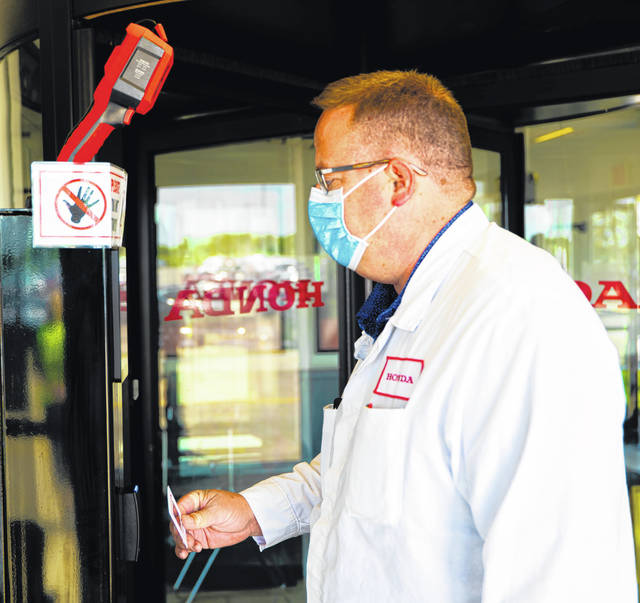
ANNA — At the beginning of the COVID-19 pandemic, companies were scrambling to find resources and solutions to problems to keep business churning. Associates with Honda Development & Manufacturing of America (HDMA), formerly Honda of America, discovered ways to use their skills to safely keep people working.
After returning to production following the automobile manufacturing suspension in March 2020, each of the Anna Honda Engine Plant’s 3,000 associates were required by state regulations to have their temperatures taken at the beginning of their shift.
“Immediately after the COVID crisis started, we knew we needed to do temperature checking of all of our associates in order to guarantee their safety,” said Karen Lewis, HDMA senior staff engineer safety department. “So we began by using a hand-held thermometer to scan every single associate as they came through our entrances, which was extremely burdensome, especially in a very short time frame. ”
Taking associates’ temperatures at the beginning of each shift was a time consuming procedure, and initially, further delayed production. Numerous associates were pulled from their primary roles in the plant to stand at entrances around the building and scan each employee’s temperature, one-by-one.
“We were tasked with the assignment with a better, more efficient way to do this. We struck on the realization that if we used a thermal camera to read the picture of the temperature of the associate, that we could get people through much quicker and wouldn’t have to have somebody within close range of someone who may be infected, so we could protect people who were doing the hand scanning,” Lewis explained.
It was Greg Cooper, American Honda senior technical specialist/manufacturing IT specialist, who is always is seeking to improve performance in all aspects at Honda, recalled information he learned at a pre-pandemic conference on thermal scans for equipment. He sought permission from supervisors in March 2020 to discover how to convert those thermal scan to be used for humans at a kiosk.
“I got wind this COVID-19 thing might force us to begin taking temperature. And sure enough, I started doing some research on my own to see if that same mechanical devise could somehow be used on human skin, and they actually had such a study. So, I proposed purchasing a few of them to my management to propose to their management, and before we knew it, we had a sample set up here in Anna, where we could very easily, non-invasive take temperatures,” Cooper said.
The kiosk Cooper’s team developed scans a person’s forehead, while looking in a mirror, and the information is visible only to the person standing in front of it. Once an acceptable temperature is scanned, the time clock scanner, located below at waist level, “wakes up” and allows the employee to scan their work badge and then enter the building for their shift.
“The process was one of the quickest I’ve ever participated in on any project I’ve ever done,” Lewis said about receiving the task in May, the team developing the kiosk scanner and then rolling them out in June, and then across North America by September.
Although there are various other types of scanners on the market, it was difficult in the spring of 2020 to locate various items such as sanitizer wipes, hand sanitizer, thermometers, and thermal scanners, so Honda associates innovation altered existing equipment and developed it’s own system to solve their needs.
“When the COVID-19 pandemic hit, Honda’s innovative associates used their manufacturing skills in new ways,” Stephanie Gostomski, North American Corporate Communications with American Honda Motor Co., said by email when describing other ways Honda responded to the pandemic. “Teams modified Odyssey minivans to transport potentially infected people. Teams also put their manufacturing skill set to work by building compressors for ventilators.”
Cooper said the feedback has been extraordinary positive and seen as a streamlined way of dealing with the COVID-19 challenge.
”It’s very settling to the associates to see kind-of a Honda-aware device being set up. By that I mean, Honda is very much a company all about respecting the individual. And rather than potentially exposing other folks that may have had a temperature. We have place-markers at all the doors to indicate where the 6-foot-limitation is leading up to the thermal imagery,” Cooper said. “This was a very gratifying experience for anyone involved with it. We got to see the absolute best of Honda.”
The minivans will continue be used as long as the need exists, and thermal scanners will continue to be used through early July 2021.


